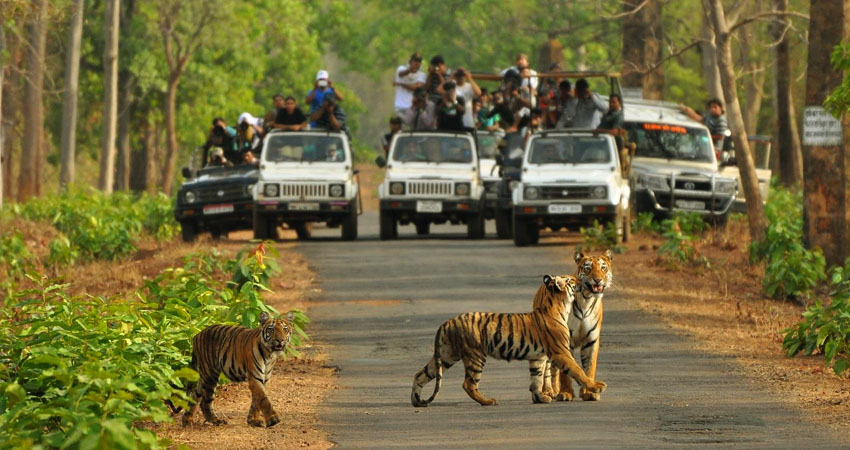
This wildlife reserve is situated in the extreme south-west of Nepal. The name of the park is derived from the largest of these grasslands which is known as Sukla Phanta. The park area is 155 sq. kms. and would be 305 sq. kms. after the completion of its extension.Sukla Phanta's grassland is one of the last remaining habitat for such threatened animals as the hispid hare and the pygmy hog. Besides these, Sukla Phanta is the stronghold for another endangered animal, the barasingha, or swamp deer. Other wildlife of the park includes spotted deer, also seen in large numbers, hog deer, nilgai, wild dog, jackal, porcupine and otter.
Small lake here attracts bird and animals alike. Herons, ducks, storks, kingfishers and egrets vie for food and swamp deer wallow at the edges. From a nearby machan one can watch while thousands of water fowl mingle on the lake surface while it is not uncommon to see hundreds of swamp deer grazing at the water-edge in the evening light. The experience is unique. Other ways to view wildlife in the park is by driving in land-Rovers near the lake and river and on nature walks with trained trackers.
Activities:
JUNGLE DRIVE
Drive into the heart of the park for a good chance to spot the rare species. The drive takes you along time-worn trails with great opportunities of viewing big animals. Don't forget to move on to Kasara, the park headquarters wherein you will get the chance to visit the Kasara Durbar and the Crocodie Breeding Centre.The centre is housed with a number of breeding and hatching ponds to produce and rear the animal until they are ready for release in the wild.
JUNGLE WALK
Walk out and stretch your legs deep into the forest accompanied by professional naturalists as they share their extensive knowledge with you on your way to prime spots in quest of rare and endemic species, Be on the look out for the great one-horned rhinoceros, wild boar, sloth bear, bison, gangetic dolphins, gharial crocodile and the Royal Bengal Tiger.
VILLAGE TOURS
Experience the uniquely placed culture of the Tharu people. Relish what their culture is like in the Tharu village Museum in the heart of Sauraha in Bachhyauli. For centuries, the Tharus have lived very close to this protected area and hence their tradition reflects their intimate relationship with the natural world. Visit the Tharu village and share their world with them as you reach out touch another culture.
Getting There:
BY OVERLAND
It is a scenic five-six hour country side drive to Chitrasari where our staff guide will receive you and transfer you to the respected Lodge in a Land Rover. which is a 30 min drive through the Eastern National Highway.
BY AIR
Bharatpur, the district headquarter of Chitwan. has an airfield with direct domestic flight connetions with Kathmandu. There are daily 3 flights operating from Kathmandu to Bharatpur and is only 25 minutes flight time. Upon arrival our representative will greet you and drive you in a Landover to Lodge.
BY RIVER RAFTING OR DRIVE
An early morning departure from Kathmandu bring you to the river rafting put-in-point. You can go river rafting for one to three days in the Trisuli river which runs parallel to prithivi highway. Our staff guide will meet you at the rafting put-in-point and transfer you to the Lodge.
Day 01
Arrival: A reception will be hosted by the Naturalist, refreshment, briefing about the program and Camp.
1400 hrs Lunch at Central Dinning Hall.
1600 hrs Visiting elephant stable and Tharu Village.
1930 hrs Dinner and briefing the program for next day.
Day 02
0600 hrs Wake up call for morning activities
0700 hrs Breakfast at Central Dinning Hall
0730 hrs Canoe ride for 30 minutes along the government authorities. River and Jungle walk. Chances to see many kinds of birds, Rhinoceros, Deer, Tiger, and many more.
1300 hrs Lunch at Hall
1500 hrs Elephant Back Safari through open grassland & forest on back and lookout for Rhino & other wild animal closely but safely.
1700 hrs Culture Program
1930 hrs Dinner and Overnight
Day 03
0600 hrs Wake up call & forward to Bird watching
0800 hrs Breakfast
0930 hrs Departure (Kathmandu/ Nepalgunj - India Border)
What You Should Bring...
Although the Terai can be cool during the winter, It can be stiflingly hot during the summer months. If you are headed there in winter, bring along a sweater or jacket. Summer months require cool clothes, good walking shoes, shady hat and sunscreen, Make sure your clothes are in colors-like brown and green-that help you blend into the background.
Carry along some mosquito repellant, anti-diarrhea tablets and anti-histamines. Meanwhile, along with photo equipment, a pair of binoculars will prove invaluable. If you are closer to the monsoon months, carry some water proof jackets and an extra pair of shoes. Just in case.
The Terai jungles are also famous for leeches that appear in the monsoon and are around for a few months after, Salt or a lighted cigarette will make them fall off, do not pull them off as the wound may get infected. Try an insect repellant to keep them away.